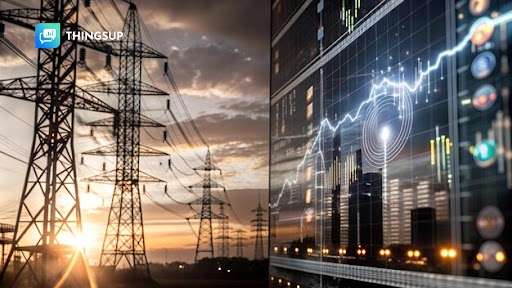According to a report by Statista, the smart grid market was about 50 billion U.S. dollars in 2022. And by 2028, this market is likely to reach 130 billion US dollars with an annual growth rate of 17.4 percent per year.
When we analyzed this data, we found that the implementation of IoT smart grids is increasing. Its demand graph also is in increasing order with time. If we talk about a completely smart grid then it comes to AMI (Advanced Metering Infrastructure), network and distribution management, and electricity supply security. All these factors together make a grid smart.
And in this journey from traditional systems to smart grids, the IoT has played the biggest role. In this blogpost we will discuss how IoT is making the modern world smarter by transforming traditional power grids into smart networks.
What is The Role of IoT in Modernizing Power Grids?
The IoT energy monitoring system has played a huge role in converting traditional grids into smart grids. Where previously data collection was difficult, IoT’s sensors, smart meters, and communication devices have made data collection more efficient and automated. Along with this, real time data collection has also been achieved. This shift enables power grids to become more adaptable, reactive, and capable of meeting the demands.
Key Components of IoT-Enabled Smart Grids
1. Smart Meters
Consumers can install IoT devices in their homes to monitor their real-time energy consumption. Besides, allow the utility company and the customer to talk back and forth, which makes billing and managing energy more accurate.
2. Grid Monitoring Systems
These are IoT solutions that collect data from different points of any grid. Such as from substations, transformers and distribution lines. The purpose of these IoT systems is to monitor voltage levels, frequency, and power quality in real time.
3. Distributed Energy Resources (DERs)
DERs include renewable energy sources such as solar panels, wind turbines, etc. IoT-enabled controllers and inverters integrate these DERs with the grid. The biggest advantage of these devices is smooth integration with decentralized energy sources.
4. Energy Storage Systems
IoT-enabled energy storage systems, like batteries, store extra energy that comes from renewable sources or when demand is low. It is possible to use these systems when demand is high or when renewable energy production is low.
5. Advanced Analytics and Machine Learning
IoT generates a lot of data from different grid components. Advanced analytics and machine learning algorithms analyze this information to identify patterns, optimize energy distribution, and predict maintenance needs.
How IoT Changes Traditional Grids into Smart Networks?
1. Collecting and Analyzing Data in Real-time
Traditional power grids received data that was either delayed or periodic, making it difficult to achieve full efficiency. Additionally, they received inefficient data with slow response times, which prevented better results.
A lot of changes came with the arrival of IoT sensors and smart meters. Previously, systems collected periodic data, but now they have started continuous data collection. Additionally, energy consumption is being significantly optimized. There is a lot of improvement in the performance of the grid. This collected data then can be transmitted in real time to centralized systems more easily.
And its impact is that the grid operators can make decisions based on accurate information in a timely manner, address problems as they occur, and optimize energy distribution in order to minimize waste and maximize efficiency.
2. Better Grid Resilience and Dependability
IoT energy monitoring systems provide detailed information about how the grid is performing. With the help of this information, operators can fix any problem before it occurs. These smart systems closely monitor important factors such as voltage levels, frequency stability, and power quality, and immediately provide warning signals if they notice any problems.
Moreover, IoT-enabled systems can notify you in advance if any equipment in the system breaks down, making it easier to detect and fix issues quickly. This helps reduce maintenance costs over time.
Its biggest benefit is that the consumer gets to see fewer outages. Which in turn helps in gaining consumer trust and satisfaction.
3. Integration of Renewable Energy Sources
The biggest challenge in modern energy management is the integration of renewable energy sources, such as solar and wind, into the existing grid infrastructure. Weather conditions can greatly increase the possibility of fluctuations in these sources. And the greater the fluctuations, the greater the instability of the grid.
Here IoT technology seems like a good way to solve this problem. IoT systems can help make the best use of renewable energy sources by monitoring and controlling them in real time. These systems help in collecting data of solar irradiance and wind speed. And using that information to adjust grid operations accordingly.
And in this way IoT can help make the grid more smarter, reliable and efficient by monitoring and controlling it in real time.
4. Cybersecurity and Grid Protection
It’s a huge possibility that cyber threats can damage power lines as they become more digitally connected and based. Malicious actors can cut off power supplies by taking advantage of weak spots in grid systems. This has big impacts on the economy and society.
And when the need arises to protect power lines from cyber threats, IoT solutions are the first to come forward. IoT systems that use advanced security methods can help protect critical infrastructure from attacks. Intrusion detection systems, firewalls, and encryption methods are some of the things that fall under this category. Along with preventing data breaches, they also prevent unauthorized access.
By improving grid security, these systems can help lower the risk of large-scale blackouts and system breakdowns, making sure that the power supply is always on and works well.
Conclusion
As we have seen how using IoT systems, traditional power grids can be easily transformed to smart networks. One of the biggest changes brought about by IoT energy monitoring system is making real-time data collection possible. And because of this our power grids have become more efficient and reliable.
As innovations in this field grow, the challenges associated with it will also be reduced. And as the challenges get resolved, the potential for smarter, greener, and more resilient power grids will grow.






